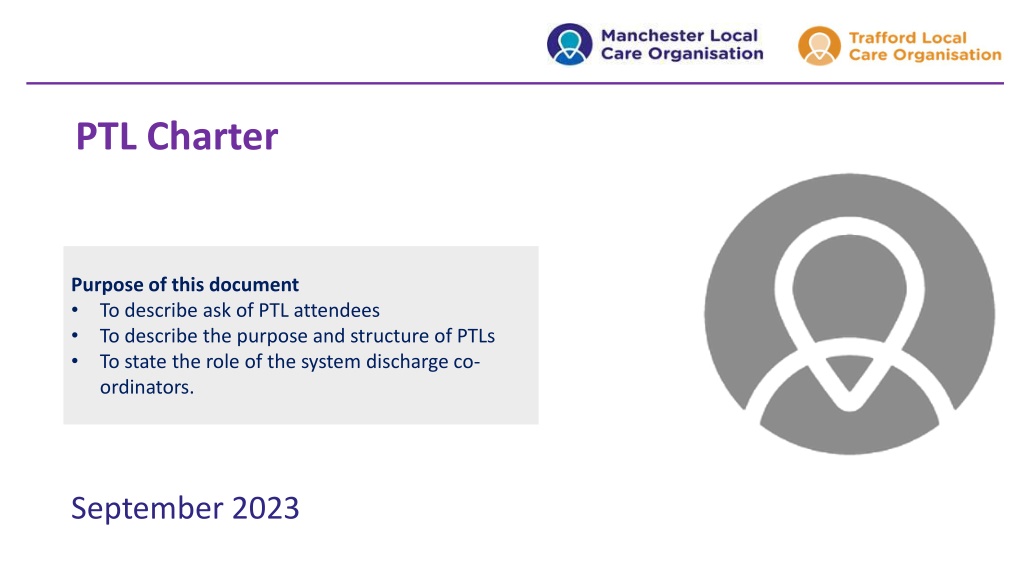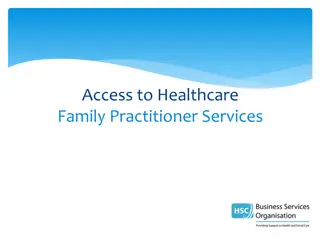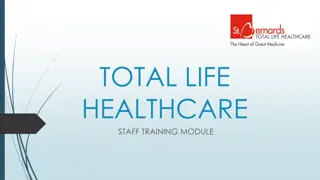Understanding the Purpose and Structure of PTLs in Healthcare
Describing the purpose and structure of Patient Tasking Lists (PTLs) in healthcare, this document outlines the roles of professionals attending PTL meetings, system discharge coordinators, and site PTLs. It emphasizes the importance of driving action on patients with delayed discharges, ensuring patient safety, and fostering a supportive environment during PTL sessions. The document also provides guidelines on running PTL meetings efficiently and managing escalations effectively.
Download Presentation

Please find below an Image/Link to download the presentation.
The content on the website is provided AS IS for your information and personal use only. It may not be sold, licensed, or shared on other websites without obtaining consent from the author. Download presentation by click this link. If you encounter any issues during the download, it is possible that the publisher has removed the file from their server.
E N D
Presentation Transcript
PTL Charter Purpose of this document To describe ask of PTL attendees To describe the purpose and structure of PTLs To state the role of the system discharge co- ordinators. September 2023
Schedule of PTLs NMGH MRI 11:30hrs 12:45hrs System discharge leads to chair meetings Wythenshawe TGH 10:30hrs 14:00hrs 2
The role of professionals attending PTLs Professionals attending PTLs should come to the sessions with a clear understanding of their role in discharge and unblocking barriers to discharge. Attendees should use the flow management process on site to drive discharge, and use PTLs to provide updates or raise requests for support On the PTL After the PTL call Before a PTL Review the most recent update on every patient who they are supporting Identify the next action which they will complete on the day Identify any support they will require, and flag these to appropriate colleagues (this can be done on the PTL call, but it is a better use of time to do so in advance) Update HIVE with the most recent information as part of BAU Contribute to making the PTL a supportive environment Provide an action focused update on every patient they are responsible for. Focus on improving outcomes and maintaining patient safety at all times. Offer constructive comments to colleagues on areas of expertise Contribute to setting clear EDD for all delays Complete all actions Update the Super PTL on HIVE Provide any briefings back to sites and teams as requested on the call Decide whether to escalate any operational issues discussed on the call We are all responsible for making the PTL a supportive environment. This means that we help each to identify solutions, and we challenge each other to put patient safety first. 3
The role and structure of site PTLs The role of the PTLs is to To be the engine room which drives action on patients who are delayed hospital with no reason to reside . Review every patient who is NRTR in an acute hospital bed Receive short updates from attendees on the next action they will complete to move a delayed patient on Identify complex cases where more in depth discussion is needed. This discussion should not happen on the PTL call. Ensure that the Super PTL is accurate and clarifying organisations responsible for net steps . The PTL is fast paced, some issues raised on a call should be discussed elsewhere, for example: Issues relating to complex discharges. Sites should agree an alternate place to house this discussion (for example at a LLOS review meeting) Confirmation that a GMSD referral has been made. Attendees should use this PTL list for this information. The following attendees must be on a PTL call A Manchester and Trafford system co-ordinator (the PTL chair) to drive the call The site IDT to update on patients delayed and known to IDT Site therapy team to update on the patients delayed on site awaiting discharge plan A site lead to own actions on behalf of the site management team and own site actions During escalation a delegated representative of the site director of operations to own actions on behalf of the site Control room lead to provide an update on the patients delayed and open to control rooms Mental health to update on patients delayed awaiting mental health support Out of area to update on the progress of out of area patients delayed How site PTLs will be ran: Each site should have a consistent structure for how PTLs are ran (this structure will flex around operational pressures and escalation levels). Out of courtesy external attendees should be invited to update first Escalations to the system will be managed by the system co-ordinator This is a minimum core attendance. Other colleagues may join as appropriate depending on operational requirements. 4
The role of the Trafford and Manchester system discharge co-ordinator System discharge co-ordinators act on behalf of the whole system Manchester and Trafford systems. In their role co-ordinators take decisions to support patient safety and maintain flow During the PTL the co-ordinator will: o Facilitate the session so that attendees give action focused updates o Keep the session to time o Run PTL sessions consistently, reflecting operational pressures, so that attendees get into a rhythm and are clear on the ask of them o Create a high support environment on PTL calls so that attendees feel empowered to give honest updates, so that issues are identified and rectified. o Ensure that all actions have clear owners o Challenge when there are opportunities for discharge to be achieved quicker o Hold attendees accountable for delivering their actions o Remove barriers to discharge o Ensure that all patients have a provisional discharge date for teams to work towards. Outside of the PTL session, the co-ordinator will: o Act as a single point of contact for the system o Identify issues for escalation to the wider system o Manage relationships between sites, control rooms and IDTs . o Report themes and issues back into the system o Provide a daily feedback report to execs at the end of each day Key messages on the role of the system discharge co- Ordinator Act as system leaders 7:30 19:30hrs for all MFT Command centres Escalate any concerns on triggers a focus on expected number of R2R delays and numbers of referrals via HIVE, Focus on home first at all times Create a high support, high challenge environment in PTL calls Remove barriers to individual discharge (micro level interventions) and redesign pathways (macrolevel interventions) if necessary Ensure that all patients have with clear EDDs for teams to work towards 5

























